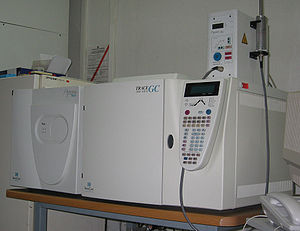CHM510
ANALYTICAL SEPARATION METHOD
EXPERIMENT 4:
ANALYSIS OF
HYDROCARBONS IN COMMON FUELS BY SOLID-PHASE MICROEXTRACTION (SPME) AND GAS
CHROMATOGRAPHY- MASS SPECTROMETRY (GC-MS)
INTRODUCTION
Solid-phase microextraction is a sample preparation technique
that use fibre coated with extracting phase that extract different kinds of
analytes for different fibre coating. The analytes can be in the form of liquid
or gas either volatile or not. In this experiment, head space SPME is used
where the fibre is exposed in the vapour phase above a gaseous sample. Head
space SPME is suitable for the analysis of volatile organic compounds, and it
is important to keep the headspace volume constant and keep the fibre position
at the same depth for every analysis. The amount of analyte extracted by the
fibre depends on the concentration of the analyte in the sample as long as
equilibrium reached. After the extraction process was done, the fibre is
transferred to the injection port of GC where desorption of the analyte takes
place and the separation occur. The factors that affect the SPME performance
are the coating material, thickness of fibre, sample agitation, sample pH, salt
addition and the extraction procedure. The objective of this experiment is to
identify the major hydrocarbons components in common fuels (diesel, petrol,
thinner and an unknown) by using SPME-GC-MS.
REAGENT AND SOLUTION
Accelerants: Unleaded petrol, diesel, paint thinner and
unknown.
INSTRUMENT
Gas Chromatograph (Agilent Technologies 6890N) equipped with
HP 5971A mass selective detector (MSD) and a 30 m x 250 µm x 0.25 µm HP5-MS capillary column.
PROCEDURE
a) Instrument Set-Up
Injector Temperature: 250oC
Detector Temperature: 300oC
Carrier Gas Flow Rate: 30
mL s-1
Column Temperature: 60oC
to 170oC at 10oC min-1
b) SPME Procedure
The fibre (100 µm polydimethylsiloxane[PDMS] in a GC Injection port was
conditioned about 10 minutes at 250oC to remove contaminants. 5mL of
sample in a glass vial was added with septum and the vial was placed on a hot
plate. The sample was heated to 50oC and agitated the sample using a
magnetic stirrer. The SPME fibre was exposed to the headspace of the vial for
20 minutes. The fibre was withdraw into the needle, pulled out from the vial
and injected into the GC-MS with desorption time 80 seconds. The major
compounds in each sample were identified using mass spectra library.
RESULTS
A.
Major compounds presence in petrol
sample;
Retention Time (min)
|
Area (%)
|
Quality
|
Compound
|
4.09
|
12.07
|
97
|
o-Xylene
|
5.63
|
2.09
|
97
|
Mesitylene
|
6.53
|
1.28
|
97
|
Benzene, 1,2,3-trimethyl-
|
7.54
|
0.39
|
97
|
Benzene, 2-ethyl-1,4-dimethyl-
|
B.
Major compounds presence in diesel
sample;
Retention Time (min)
|
Area (%)
|
Quality
|
Compound
|
10.66
|
10.17
|
94
|
Tridecane
|
11.79
|
3.11
|
98
|
Decahydro-1,1,4a,5,6-pentamethylnaphthalene
|
12.02
|
15.13
|
97
|
Tetradecane
|
14.79
|
4.26
|
98
|
Hexadecane
|
C.
Major compounds presence in thinner
sample;
Retention Time (min)
|
Area (%)
|
Quality
|
Compound
|
2.80
|
100.00
|
91
|
Toluene
|
D.
Compound of unknown that match with
compound in petrol;
Retention Time (min)
|
Area (%)
|
Quality
|
Compound
|
6.05
|
8.25
|
95
|
Benzene,1, 2, 3-trimethyl-
|
6.53
|
3.68
|
93
|
Mesitylene
|
E.
Compound of unknown that match with
compound in petrol;
Retention Time (min)
|
Area (%)
|
Quality
|
Compound
|
9.22
|
9.84
|
95
|
Dodecane
|
11.79
|
2.85
|
99
|
Decahydro-1, 1, 1, 4a, 5, 6-pentametylnaphthalene
|
12.01
|
8.92
|
97
|
Tetradecane
|
13.29
|
3.69
|
96
|
Pentadecane
|
DISCUSSION
From the analysis done, 4 major compounds presence in petrol
sample are o-xylene, mesitylene, benzene, 1, 2, 3-trimethyl- and benzene,
2-ethyl-1, 4-dimethyl- that lie from retention time of 20 minutes to 33 minutes
of analysis. Diesel sample show the trend of major compound peaks from 7
minutes to 18 minutes that respond to tridecane, decahydro-1, 1, 4a, 5,
6-pentamethyl-naphthalene, tetradecane and hexadecane based on the mass spectra
library.
The unknown
sample analysis shows that the unknown sample is the combination of diesel and
petrol based on the similarities of some of the major compounds presence in
diesel and petrol. The major compounds presence in the unknown are Benzene,1,
2, 3-trimethyl- and mesitylene
that is presence in petrol while dodecane,decahydro-1, 1, 1, 4a, 5,
6-pentametylnaphthalene, tetradecane,
pentadecane presence in diesel.
There is a retention time that is presence in thinner and the unknown that at
2.54 minutes, but since the quality is lower that is 64, the assumption cannot
be made because it has the possibilities to be other compounds. The advantage
of using SPME is that the extraction is simple, fast and can be done without
any solvents. If the samples are properly stored, it can be analyzed days later
without much loss of volatiles.
CONCLUSION
The major compounds presence in petrol o-xylene, mesitylene,
benzene, 1, 2, 3-trimethyl- and benzene, 2-ethyl-1, 4-dimethyl-. The major
compounds presences in diesel are tridecane, decahydro-1, 1, 4a, 5,
6-pentamethyl-naphthalene, tetradecane and hexadecane. Thinner only show a
single peak that corresponds to toluene. It can be concluded that the unknown
sample is the mixture of diesel and petrol since there are some major compounds
of diesel and petrol presence in the unknown.
REFERENCE
1. Nor’ashikin S., Ruziyati T., Mardiana
S. (2012), Analytical Separation Methods Laboratory Guide (2nd edition).








No comments:
Post a Comment